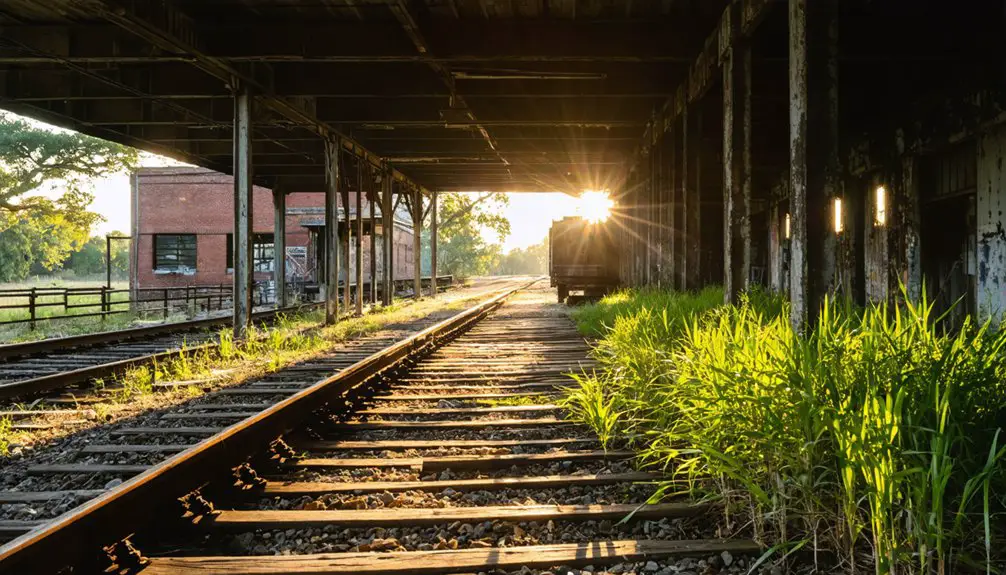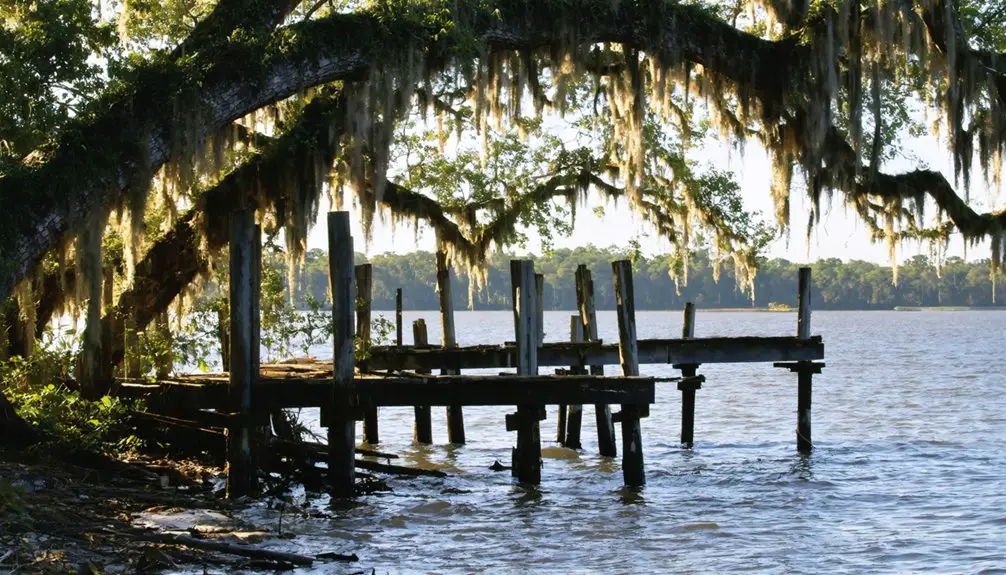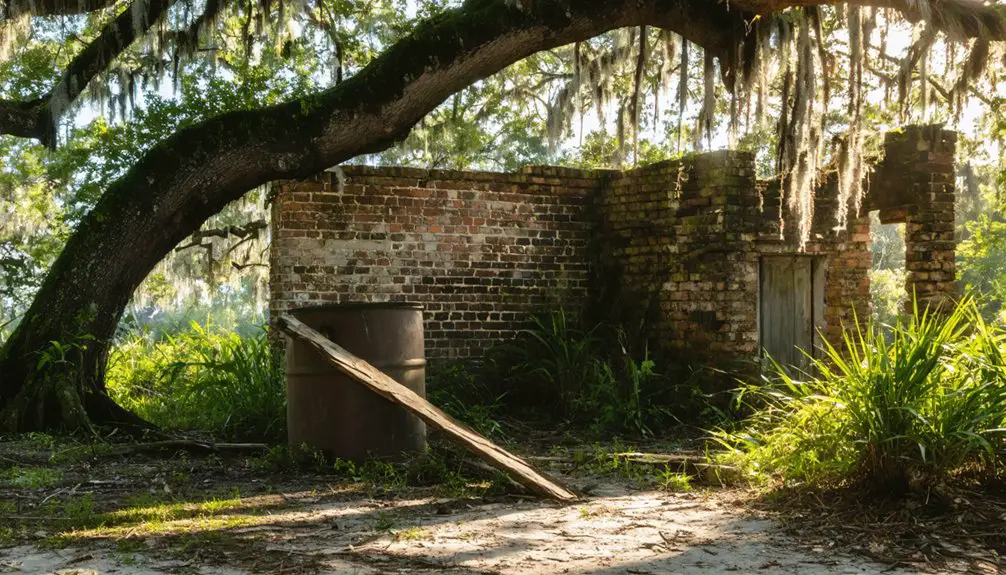You’ll find West Tocoi’s remains along Florida’s St. Johns River, where this strategic settlement once connected Jacksonville to St. Augustine. After the Civil War, it flourished as an essential transportation hub with coordinated rail and ferry services, charging $2.00 for passage to St. Augustine in 1870. The town’s prosperity ended when Flagler’s Florida East Coast Railroad bypassed it in 1892. Today, scattered pilings and cracker houses tell a deeper story of this forgotten riverside community.
Key Takeaways
- West Tocoi was a bustling river settlement on Florida’s St. Johns River that became abandoned after railroad expansions in the 1890s.
- The town served as a crucial transportation hub connecting Jacksonville to St. Augustine through combined railroad and steamboat operations.
- West Tocoi’s economy thrived on naval stores, lumber trade, and ferry services until Flagler’s Florida East Coast Railroad bypassed the town.
- Physical remnants include dock pilings along the St. Johns River and examples of Florida “cracker house” architecture.
- The settlement’s decline began in 1892 when new railroad routes eliminated the need for its ferry and stagecoach services.
The Rise of a River Settlement
As the Civil War’s devastating impact began to fade, West Tocoi emerged as an essential river settlement on the St. Johns River’s west bank.
Located at 29°50′42″N 81°33′28″W, the settlement evolved into a strategic trading post that defined the region’s development.
You’ll find that settlement dynamics centered around the bustling steamboat landing, where merchants shipped rough sawn lumber, naval stores, and agricultural products to enthusiastic markets. The strategic location quickly attracted homesteaders who recognized the area’s potential for commerce and trade. The Timucuan indigenous people had inhabited this land for centuries before European contact.
Cultural influences shaped the community as it evolved into a crucial transportation hub, connecting Jacksonville, Green Cove Springs, and St. Augustine.
You’d have seen a steady stream of cattle, hogs, and exotic animal skins moving through the port, while the Tampa/Jacksonville Railroad brought passengers to cross the river by ferry.
This confluence of rail and river traffic transformed West Tocoi into a thriving commercial nexus.
Native American Origins and Early History
Before European settlers transformed the landscape, the Timucuan people made their home along the St. Johns River, where they established essential transportation networks and gathering sites.
Along Florida’s St. Johns River, Timucuan settlements once flourished, creating vital pathways and community spaces across the waterways.
You’ll find their indigenous heritage reflected in the very name “Tocoi,” which means “shallow crossing” or “water lily” in their native tongue.
The cultural significance of this location stems from its role as a key river crossing point, where native trails converged to facilitate trade and movement.
The Timucuans masterfully used these waterways for fishing, hunting, and small-scale agriculture.
After Spanish colonization began in 1565, the area’s native populations faced increasing pressure from European settlements and plantations.
Despite these challenges, their legacy endures through place names and the historic trails they established throughout the region.
Later settlements like Nansi Wiggins’ plantation would be established near Tocoi, continuing the area’s agricultural tradition.
Transportation Hub and Commercial Growth

Following the Civil War, you’ll find West Tocoi emerged as a crucial transportation nexus where the Jacksonville, Tampa and Key West Railroad converged with steamboat operations on the St. Johns River.
Passengers paid $2.00 per ticket for transport between Tocoi and St. Augustine in 1870.
Your journey through this era would reveal how the railroad’s integration with ferry services created a safer route to St. Augustine, allowing travelers to avoid treacherous ocean passages.
The river docks buzzed with commercial activity as steamboats regularly loaded lumber, naval stores, and agricultural products bound for larger markets like Jacksonville.
Railroad and Ferry Integration
When the Jacksonville, Tampa and Key West Railroad established its West Tocoi stop in March 1884, the town emerged as a significant transportation nexus linking rail and water travel.
Railway innovations included primitive wooden rails overlaid with sheet iron, reflecting early railroad technology that would soon modernize. The railway’s early operations were notably hampered by tired mules obstructing tracks, causing frequent delays and passenger frustration. The area would later benefit from Henry Flagler’s leadership in modernizing Florida’s rail infrastructure.
The integration of rail and ferry connections created an efficient transportation system that you’d find indispensable for:
- Accessing safe inland routes while avoiding dangerous ocean travel
- Transferring seamlessly between trains and ferries across the St. Johns River
- Connecting to the St. Johns Railroad’s open-air steam engines for further travel
The coordinated timetables between rail and ferry services transformed West Tocoi into a crucial hub for commerce and tourism, though this prominence would later decline with Flagler’s railroad expansion.
River Trade Operations
The bustling port of West Tocoi emerged as an essential commercial powerhouse along the St. Johns River, capitalizing on its strategic location south of Green Cove Springs.
You’d find the dock teeming with activity as steamboats navigated the river, loading rough-sawn lumber, naval stores, and seasonal crops bound for distant markets.
As a crucial hub for cargo transportation, West Tocoi’s river navigation system connected local producers to broader commercial networks.
You could witness the daily bustle of workers handling diverse cargo, from animal skins destined for Jacksonville tanneries to timber harvested from the surrounding forests.
The port’s name, meaning “shallow crossing,” reflected its natural advantage as a crossing point, while its infrastructure supported the thriving naval stores industry and agricultural trade that defined the region’s economic prosperity.
Economic Foundations and Industries
You’ll find that West Tocoi’s economic significance centered heavily on its naval store operations, where workers extracted and processed pine tree products like turpentine and rosin for maritime use.
As a bustling river trade hub, the town’s position on the St. Johns River enabled efficient distribution of these naval supplies along with lumber, agricultural goods, and animal products to major markets.
The presence of permanent turpentine workers’ quarters and extensive dock facilities demonstrates how deeply these industries were embedded in West Tocoi’s commercial identity.
Naval store operations formed the economic backbone of West Tocoi before and after the Civil War, capitalizing on the region’s abundant longleaf pine forests. The industry’s economic impact transformed this riverside settlement into a bustling commercial hub, where workers extracted valuable products from pine trees through a labor-intensive process known as turpentining.
The naval stores industry at West Tocoi centered around three primary activities:
- Harvesting pine gum through strategic tree scoring and collection
- Processing raw materials into turpentine and rosin for shipbuilding
- Transporting finished products via steamboat to northern markets
You’ll find that West Tocoi’s strategic location on the St. Johns River made it an ideal shipping point, allowing merchants to efficiently distribute naval stores products while supporting the region’s diverse economic base of farming, timber, and livestock industries.
River Trade Hub
Building upon its naval stores foundation, West Tocoi emerged as a significant river trade hub along the St. Johns River. You’d find the docks bustling with activity as steamboats loaded diverse cargo, from rough-sawn lumber to seasonal agricultural products.
The river trade dynamics centered on the town’s strategic location, where you could witness livestock, particularly cattle and hogs, gathered for northern markets.
The hub’s economic sustainability relied on a complex network of interconnected industries. You’d see animal skins from bear, panther, and alligator collected for Jacksonville tanneries, while nearby Spanish moss processing added to the commercial diversity.
The transportation infrastructure, including rail connections to St. Augustine, created an essential nexus linking inland resources to broader markets until Flagler’s railroad realignment altered the region’s economic trajectory.
Life Along the St. Johns River

Life along the St. Johns River intertwined native Timucuan cultural traditions with European settlements, creating a vibrant tapestry of river ecology and daily activities.
Ancient Timucuan ways merged with European culture along the St. Johns River, weaving nature and civilization into daily riverside life.
You’d find indigenous communities and later colonists positioning their homes strategically along the riverbanks, maximizing access to essential resources and transportation routes. Archaeological evidence shows that native peoples created large shell middens from discarded shellfish remains, marking their long-term habitation sites.
The river’s significance manifested in three key aspects:
- Transportation networks connecting plantations, towns, and global trade routes
- Community gathering spaces featuring wharves, markets, and social centers
- Economic foundations supporting diverse businesses from warehouses to health resorts
You’d witness steamboats carrying citrus and timber downstream while delivering household goods to upriver settlements. Residents commonly used ox-drawn wagons to transport their logs and citrus to the riverside trading posts.
The riverside communities thrived with newspapers, post offices, and scenic greenways until railroad development shifted transportation patterns, forever changing life along these historic waters.
The Decline and Abandonment
Once Henry Flagler completed his Florida East Coast Railroad in 1892, West Tocoi’s fate was sealed.
You would’ve witnessed the town’s rapid economic decline as the crucial St. Johns Railroad and ferry service became obsolete. The new railroad bypassed West Tocoi entirely, redirecting passengers and freight through more efficient routes to St. Augustine and points south.
These transportation shifts devastated the local economy. The orange groves and Spanish moss factory couldn’t sustain the town without reliable transport links. Like many Florida settlements, the town’s prosperity was deeply tied to its railroad intersection location.
Some old wooden pilings still stand a quarter-mile into the St. Johns River as silent reminders of the bustling port that once was.
You’d have seen residents departing for better opportunities elsewhere, leaving behind only scattered industrial structures. By the mid-1890s, the stagecoach and ferry services had shut down, eliminating fundamental trade connections.
What remained was a shell of the former transit hub, with only turpentine worker quarters persisting into the 1930s and 1940s.
Historical Legacy and Physical Remnants

Despite its eventual decline, West Tocoi’s historical imprint endures through scattered physical remnants and a rich industrial legacy.
You’ll find evidence of its cultural heritage in the remaining pilings along the St. Johns River and the ruins of 1930s turpentine worker quarters, often mistaken for old motels.
The area’s historical significance is preserved through three key elements:
- Original “cracker houses” that showcase Florida’s vernacular architecture
- The preserved dock area where lumber, naval stores, and animal skins were once loaded
- The site’s indigenous roots, marked by the name “Tocoi” itself, meaning “shallow crossing”
These remnants tell the story of West Tocoi’s evolution from Native American crossing to bustling industrial port, reflecting its essential role in Florida’s development.
Frequently Asked Questions
What Happened to the Families Who Lived in West Tocoi?
You’ll find historical records show families migrated away when Tocoi’s economy collapsed, with most relocating to growing cities like Jacksonville or Green Cove Springs seeking new opportunities.
Were There Any Famous Shipwrecks or River Disasters Near West Tocoi?
Like waves of misfortune, you’ll find shipwreck history near Tocoi centered on the treacherous St. Augustine inlet, where vessels faced disaster every few weeks while crossing dangerous sandbars during evacuation periods.
Did West Tocoi Have a School, Church, or Cemetery?
Based on available records, you won’t find evidence of a school history, church significance, or cemetery in this location. It functioned primarily as an industrial port rather than a residential community.
What Natural Disasters or Epidemics Affected West Tocoi’s Population?
Like dark storm clouds gathering, you’d have faced devastating hurricane impacts along the St. Johns River, while disease outbreaks typical of Florida’s river ports likely struck the vulnerable community.
Were There Any Notorious Crimes or Outlaws Associated With West Tocoi?
You won’t find any documented outlaw tales or notable crime history associated with this location. Historical records show it was primarily a peaceful commercial hub focused on transportation and trade.
References
- https://historiccity.com/2010/staugustine/news/historic-city-memories-ghost-towns-3-2621
- https://www.claytodayonline.com/stories/flaglers-railroad-killed-clay-countys-west-tocoi
- https://historiccity.com/2010/staugustine/news/historic-city-memories-ghost-towns-2510
- https://www.florida-backroads-travel.com/old-florida-towns-on-the-st-johns-river.html
- https://www.ghosttowns.com/states/fl/westtocoi.html
- https://en.wikipedia.org/wiki/Tocoi
- https://en.wikipedia.org/wiki/Tocoi_Creek
- https://www.legendsofamerica.com/fl-staugustine/
- https://www.claytodayonline.com/stories/west-tocoi-clay-countys-transportation-hub-for-lumber-naval-stores-and-crops
- https://myfloridahistory.org/webextras/webextras/16



